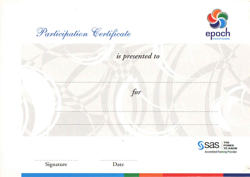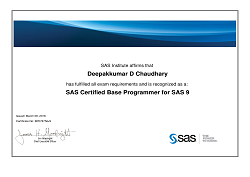- Home
- SAS® Certified Clinical Trials Programmer
SAS® Certified Clinical Trials Programmer
How its Designed! Our new training program combines coursework and hands-on learning for you or your team to gain valuable clinical research theory and data analysis skills. Engage In Practical Study Of Clinical Research Theory & Date Analysis. 24*7 Access with Online Training (Instructor Led Live Web Training Program) What's it all about? The academy offers multi tracks based on career aspirations: Discover High-Quality Courses On All The Topics You Care About. Start Your Course Today And Join Over Million People Learning Online at Epoch! Join epoch Today. Enrol now. Advance your Career. Easy Access/Simple Learning. Affordable fees.
Power up your staff’s skills and boost your business
Course Description
The pharmaceutical industry is bursting at the seams with data and looking for talented, skill full programmers. SAS® is the de facto standard platform used for clinical trials data analysis and reporting for new product submissions to regulatory authorities. SAS® is widely recognized as the gold standard for determining safety and efficacy for clinical trials. SAS® is also the primary mechanism for preparing analysis-ready data for traditional clinical research safety and efficacy analysis activities.
Now with Clinical SAS Online Training one can easily get training started without having to travel. Plus with flexible batch timing & online lab access options it makes it easy for candidates to clip and usage their time in best possible fashion.
About Program
This 3 months of extensive bootcamp training program will not only cover detail about data manipulation, generation of tables and graphs but it also make you industry ready with clinical research theory and case studies based on phase trials. This program also help candidate in preparation of SAS Certified Clinical SAS Programmer credentials.
Entire course is exhaustive of Practical learning Guide to Clinical Research Trial Design, Analysis & Reporting. With use of official SAS Software unwind the true multi software features and systems. Further enhance understanding and in depth understanding of usage of SAS programming in Clinical research trial for pharmaceutical industry new drug development and BA/BE studies. Finally put your hands on to Analysis in Clinical Trial with Real time case study developed by Leading industry experts and associate CRO/Pharma companies.
Learn: Clinical Trial Fundamentals, SAS Programming, Generate Tables Listing Graphs, CDISC, STDM, AaDM and much more....Further to this, participants will be able to get hands on training/experience with mock assignments
Assessment and evaluation mechanism developed will help participants to build and grow their profile similar to the level of experience professional. Combination of relevant Theoretical and Practical exposure, together will enable profiles to work in the industry with ease and satisfy the severe shortage of skilled manpower of growing clinical research industry.
Format of Training
Taught by certified instructors at High-Tech facilities across the country:
- A SAS expert at your side.
- Focused learning away from the office
- Networking opportunities
- State-of-the-art facilities
- Electronic course notes downloadable to your device and permission to print
- Business Knowledge Series: in-depth courses on the latest business topics
- We offer Connected Classes! Watch for courses in Cary, New York, Arlington, Dallas and San Francisco that connect remote students via our Live Web classroom.
Live Web Classroom
Training is Led by an expert instructor live online using live web training platform, and this are not pre recorded lectures. Trainer can virtually look over your shoulder. Discuss, share, exchange ideas with students from different countries.
Taste of Live Web - is a perfect platform for indivudals who fear online training. SAS® gives an opportunity to all the registrants to have a closer look at different courses given below with a blend of Online Learning.
All the benefits of the classroom without the travel:
Classroom training options include courses offered in our regional training centers or via our Live Web classroom.
Prerequisite
Who should attend
This program enable candidate to become clinical SAS® programmer by undergoing comprehensive training which includes case studies, and industry level project work. All candidates are expected to have good aptitude and be familiar with overall computer programming skills.
Candidates are Preferred From
Graduates or Post Graduates from
- Life Sciences - B. Sc./ M. Sc.,
- Pharmacy - B. Pharmacy / M. Pharmacy
- Statistics - B. Sc. / M. Sc.
- Medical - MBBS, BDS, BHMS, BAMS
- Engineering - BE / B. Tech (Biotechnology, Bioinformatics, Computer Science) or M. Tech
Or Relevant experience of pharmaceutical/life science industry
Training Features
48 hours of Instructor-led Classes.
- Classroom: 6 Days/48 Hrs
- Live Web Classroom: 12 half-day session(s)
- e-Learning: 24 Hr/180 Day License (Free)
Course includes embedded practice content for strenthening programming skills.
One attempt of Global certification worth $180
The perfect starting point for those interested in a career as a SAS® professional. Successful candidates should have experience in programming and data management using SAS®9.
Validate your skills. Stand out.
- Earn recognition for your knowledge.
- Increase your value to your employer.
- Enhance your credibility as a SAS professional.
- Get a digital badge you can share.
Course Curriculum
SAS® Certified Base Programmer for SAS®9 - Certification
The perfect starting point for those interested in a career as a SAS® professional
Successful candidates should have experience in programming and data management using SAS®9 and should be able to:
- Import and export raw data files.
- Manipulate and transform data.
- Combine SAS data sets.
- Create basic detail and summary reports using SAS procedures.
- Identify and correct data, syntax and programming logic errors.
Candidates who earn this credential will have earned a passing score on the SAS® Base Programming for SAS®9 exam.
Exam Content & Pricing
This exam is administered by SAS and Pearson VUE.
- 60-65 multiple-choice and short-answer questions.
(Must achieve score of 70 percent correct to pass) - 110 minutes to complete exam.
- Use exam ID A00-211; required when registering with Pearson VUE.
- This exam is based on SAS 9.4.
Exam Content & Pricing
Candidates who earn this credential will have earned a passing score on the SAS® Base Programming for SAS®9 exam.
This exam is administered by SAS and Pearson VUE.
- 60-65 multiple-choice and short-answer questions.
(Must achieve score of 70 percent correct to pass) - 110 minutes to complete exam.
- Use exam ID A00-211; required when registering with Pearson VUE.
- This exam is based on SAS 9.4.
Exam - Location
Epoch has three faclities approved for conducting exam.
Course Logistics and Overview
- course logistics
- SAS/GRAPH and ODS graphics
- introduction to SAS/GRAPH
- graph gallery
Graphical Reporting with SAS/GRAPH
- how SAS/GRAPH creates output
- SAS/GRAPH program structure
- controlling the appearance of your graphs
Producing Scatter and Line Plots
- creating scatter plots
- creating line plots
- creating plots containing multiple lines
- creating other types of plots with individual data points
Producing Bar Charts
- creating vertical and horizontal bar charts
- creating grouped and subgrouped bar charts li>creating bar-line charts
Producing Other Types of Charts
- creating pie charts
- creating star charts
- creating radar charts
- creating tile charts
- creating key performance indicator charts
Customizing the Appearance of SAS/GRAPH Output
- colors and fonts
- customizing common graphics elements
- titles and footnotes
- customizing plot symbols
- specifying chart pattern colors
Customizing Axes and Legends
- customizing plot and chart axes using procedure options
- customizing axes with AXIS statements (basic options)
- customizing axes with AXIS statements (additional options)
- customizing legends
Annotating Graphs
- introduction to annotate
- defining annotate variables
- using annotate macros
- creating data-dependent annotations
Generating Graphs for Use in Other Applications
- creating image files
- creating client-rendered graphs
- creating clickable graphs for the web using ODS
Managing and Replaying SAS/GRAPH Output
- storing and naming graphics output
- using the GREPLAY procedure
Learning More
- additional SAS resources
- beyond this course
SAS Macro Language 1: Essentials
This course focuses on the components of the SAS macro facility and how to design, write, and debug macro systems. Emphasis is placed on understanding how programs with macro code are processed.
Learn how to
- perform text substitution in SAS code
- automate and customize the production of SAS code
- conditionally or iteratively construct SAS code
- use macro variables and macro functions.
SAS SQL 1: Essentials
This course teaches you how to process SAS data using Structured Query Language (SQL).
Learn how to
- query and subset data
- summarize and present data
- combine tables, including complex joins and merges
- create and modify table views and indexes
- replace multiple DATA and PROC steps with one SQL query.
SAS Programming 3: Advanced Techniques and Efficiencies
This course is for SAS programmers who prepare data for analysis. The comparisons of manipulation techniques and resource cost benefits are designed to help programmers choose the most appropriate technique for their data situation.
Learn how to compare various SAS programming techniques that enable you to
- benchmark computer resource usage
- control memory, I/O, and CPU resources
- create and use indexes
- combine data horizontally
- use hash and hiter DATA step component objects and arrays as lookup tables
- compress SAS data sets
- sample your SAS data sets
- create and use SAS data views
- safely reduce the length of numeric variables
- create user-defined functions and informats.
Introduction
- overview of SAS Foundation
- course logistics
- course data files
- introducing the Structured Query Language
Basic Queries
- overview of the SQL procedure
- specifying columns
- specifying rows
Displaying Query Results
- presenting data
- summarizing data
SQL Joins
- introduction to SQL joins
- inner joins
- outer joins
- complex SQL joins
Subqueries
- noncorrelated subqueries
- in-line views
Set Operators
- introduction to set operators
- the UNION operator
- the OUTER UNION operator
- the EXCEPT operator
- the INTERSECT operator
Creating Tables and Views
- creating tables with the SQL procedure
- creating views with the SQL procedure
Advanced PROC SQL Features
- dictionary tables and views
- using SQL procedure options
- interfacing PROC SQL with the macro language
Learning More
- SAS resources
- beyond this course
Introduction
- course logistics
- purpose of the macro facility
- program flow
Macro Variables
- introduction to macro variables
- automatic macro variables
- macro variable references
- user-defined macro variables
- delimiting macro variable references
- macro functions
Macro Definitions
- defining and calling a macro
- macro parameters
DATA Step and SQL Interfaces
- creating macro variables in the DATA step
- indirect references to macro variables
- creating macro variables in SQL
Macro Programs
- conditional processing
- parameter validation
- iterative processing
- global and local symbol tables
Learning More
- SAS resources
- beyond this course
Supplemental Materials
- program flow
Introduction to Reporting and ODS
- course logistics
- introduction to reporting
- introduction to ODS
- ODS with the SAS interfaces
- creating reports with the PRINT procedure
Getting Started with the TABULATE Procedure
- introduction to the TABULATE procedure
- creating the structure of the table
- adding overall summarizations
- adding additional statistics
Doing More with the TABULATE Procedure
- enhancing with labels and formats
- enhancing with options
- adding trafficlighting
- adding additional style attributes
Getting Started with the REPORT Procedure
- introduction to the REPORT procedure
- creating a detail report
- creating a summary report with the GROUP usage
- creating a summary report with the ACROSS usage
- computing an additional column
Doing More with the REPORT Procedure
- adding summary lines
- customizing break lines
- adding trafficlighting and style attributes
- using the CALL DEFINE statement
Using ODS Destinations
- introduction to ODS destinations
- PRINTER and RTF destinations
- CSV and HTML destinations
- Excel and other destinations
- SAS destinations
Doing More with ODS
- using ODS options and statements
- using ODS ESCAPECHAR
- controlling bookmarks and the table of contents
- using ODS layout
Introduction to SG Procedures
- introduction to ODS graphics
- using the SG procedures
Learning More
- introduction
Classroom Training on SAS Programming & Practice Sessions
Assessment & Evaluation
Placement Assistance
Clinical Trial Theory
- Introduction To Clinical Research
- Basic Pharmacology & Pharmacy in CR
- New Drug Development
- Guidelines For Clinical Trials (ICH – GCP)
- Ethics in Clinical Research
- Regulations in Clinical Research
- Biostats & Clinical Trial Designs
- Clinical Trial Documents
- Quality in Clinical Trials
- Clinical Trial Management -Project Management
- Drug Safety & Pharmacovigilance
- Clinical Data Management
- Standards for Clinical Data Interchange – SDTM and ADaM Clinical Trial
Clinical Programming: Project & Case Study
- CRF Annotation
- Dataset Development
- Mapping Dataset (STDM) (Laboratory)
- ADaM dataset development (ADVS)
- Creating Adverse Event Summaries
- Dataset Validation
- Shift Tables (Laboratory Domain)
- Generating Tables & Listing
- Obtaining Descriptive Statistics
- Generating CRT-DDS Define.xml Files
Project
- Importing Mock Clinical Trial Data
- Transforming Data and Creating Analysis
- Creating Tables and Listings
- Creating Continuous/Categorical Summary Tables
- Creating Adverse Event Summaries
- Creating a Laboratory Shift Table
- creating a standard CRT-DDS Define.xml document
- creating customized CRT-DDS Define.xml documents
- loading the DM (Demographics) domain
- loading the XP (Pain Diary) domain
- loading the SUPPDM (Supplemental Demographics) domain
- loading the QS (Questionnaire) domain
- Common Clinical Trial Graphs
- Scatter Plot
- Line Plot
- Bar Chart
- Box Plot
- Kaplan-Meier Survival Estimates Plot
- Introduction to Bio - Statistics
- Obtaining Descriptive Statistics
- Using PROC FREQ to Export Descriptive Statistics
- Using PROC UNIVARIATE to Export Descriptive Statistics
Certificate
Success Stories
Hi, this is Debasis. I would like to convey my heartfelt gratitude to Epoch for shaping my career in SAS. Back of my mind I wanted to move to IT sector,...
Read More
Debasis Sahoo
FAQs
Candidate must take the exams within 15 Days for Clasroom Training Program & 3 Months for Live Web Training Program of the training completion date.
Yes! Students in the self-paced format can purchase practice exams from Pearson Vue. Practice exams are included in the instructor-led classroom format.
Yes, there are interest-free installments options available for courses. Please connect for more details
Candidate earns a Digital Learning Badge at the end of training and a Digital Certification Badge on clearing the global exam.
Official SAS curriculum is delivered only by SAS India/Accredited Training Centres. Pedagogy is designed using a combination of comprehensive course notes, lectures, hands-on exercises, software demonstration, assessments & more. SAS Accredited trainers, besides being expert in their subject matter, communicate the SAS official curriculum very effectively using internationally accepted & proven instructional skills. Further candidates will also earn a SAS Digital Badge that illustrate and verify professional skills. With real-time verification, colleagues and potential employers have a clear view of what you’ve learned through your SAS® training.
All the above is certainly not possible when you get trained from an Unauthorized / Local institute claiming to teach SAS.
Contact an Academic Consultant: info@epoch.co.in || +91 7829487000 || +91 8155837000
Or Visit us
1st Floor Innovation, No 101, Amarjyothi HBCS Layout, Domlur
Karnataka - 560 071
We Accept All Payment Methods!!!!
Our mission is to enable the use and adoption of SAS Software. All courses offered by SAS are a mix of concepts and practical's to support the concepts. we follow a unique delivery mode of
1. Business Scenario based do-along demonstration
2. Exercise to reinforce the concept learnt
3. Poll questions to further validate the concepts and prepare for certification
4. Case study & Project where ever applicable
Quertestian, Cognizant , TCS, Accenture, ICON, inventive Health, Sciformix, Genpact, Novartis, GSK Pharma, Karmic Life Sciences, Biocon, Quintiles, Alcon , AstraZeneca, Solvey pharmaceuticals, Pfizer, GVK, Infosys, Omnicare, Lamda Therapeutics, PPD, Alcon, Theorem Clinical research, Quantitate and many more …
There are many organisation that hires from epoch depending on their staffing requirement.
At epoch, the task is not over with the completion of the program. Team epoch provides active placement support to candidates enrolled in career-oriented courses. Our professionals are on constant lookout for the job opportunities to match the profiles of the candidates. Moreover, our trainers ensure that the candidates are groomed well to undergo the recruitment process and understand his/her role in leveraging opportunities. For More Details please contact us
epoch has been partner with multiple CRO/Pharma Organisation where candidate are recutired as Internship to enhance career.
Internships are both paid and unpaid and mix of for both.

 Course Description
Course Description About Program
About Program Format of Training
Format of Training Prerequisite
Prerequisite Training Features
Training Features Course Curriculum
Course Curriculum Project
Project Certificate
Certificate Success Stories
Success Stories FAQs
FAQs Course Fees
Course Fees

 Watch
Watch Contact
Contact


 Find My Path
Find My Path